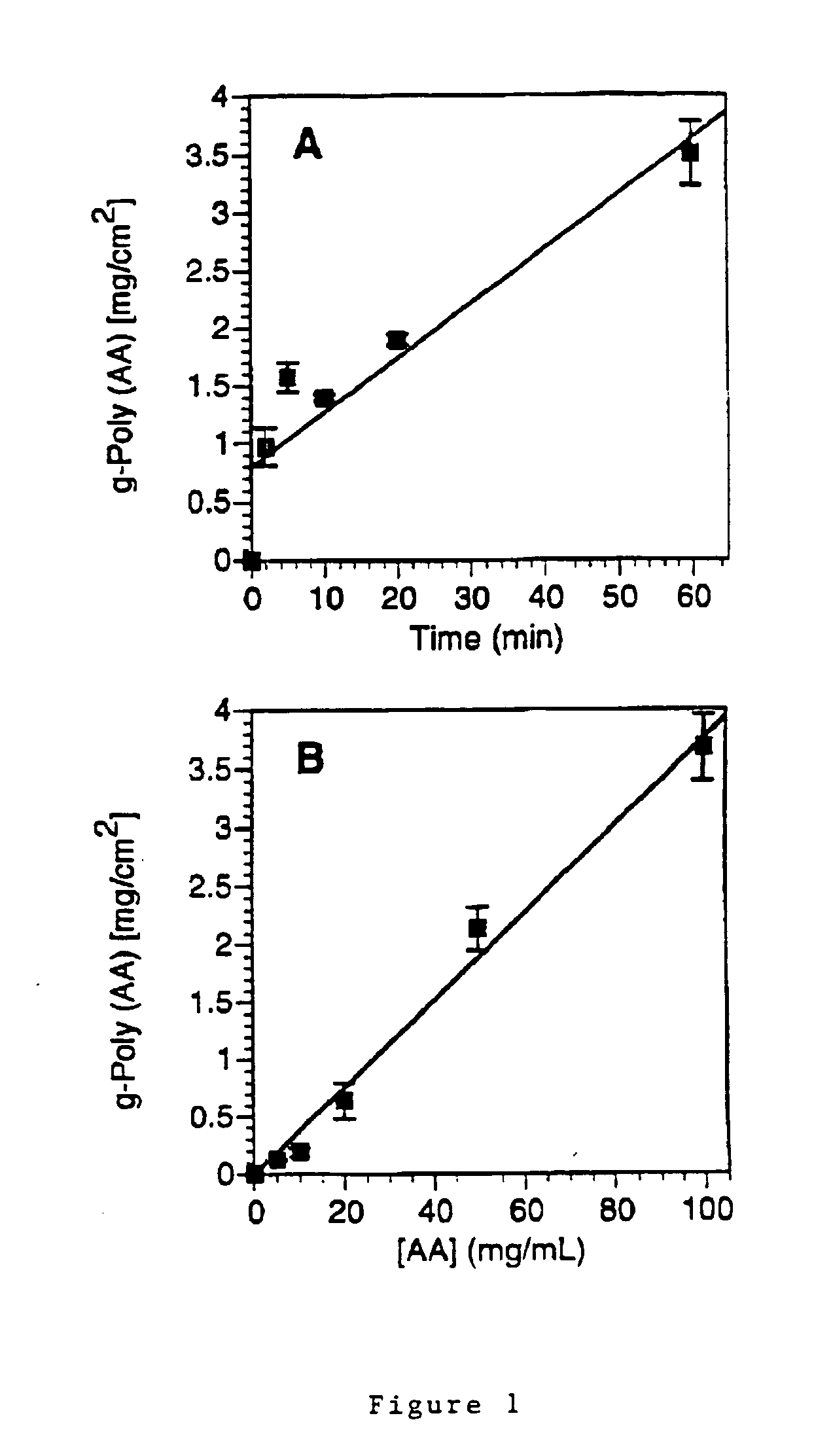Modified Anti-microbial surfaces, devices and methods
a technology of anti-microbial surfaces and devices, applied in the direction of catheters, packaged goods, pharmaceutical non-active ingredients, etc., can solve the problems of device slippery, significant diminishing the value of end product, and complication of us
- Summary
- Abstract
- Description
- Claims
- Application Information
AI Technical Summary
Benefits of technology
Problems solved by technology
Method used
Image
Examples
example 1
Preparation of Acrylate-Modified Silicone Surface
[0078]Pre-weighed silicone disks (approximately 0.7 cm in diameter, 0.2 cm in thickness) or cylindrical sections (approximately 0.5 cm in diameter, 1 cm in length) were incubated in a methanol solution of photo-initiator (BPB; or p-benzoyl benzoic acid, BBA) for 1 hour followed by air drying at about 40° C. for 2 hours. Samples were then suspended in vials containing 3 mL of aqueous monomer solution. When required, monomer solutions were saturated with BPB. The aqueous solubility of BPB was 4 μg / mL. All solutions were filtered through 0.22 μm pore filters prior to being flushed with nitrogen for 15 min. Vials were sealed with rubber septa and placed 2.5 cm beneath a pair of UVA bulbs (15 W ea.). Radiation intensity at the sample site was 3.8 mW / cm2 as determined by UV actinometry (Zhang, J. Y.; Esrom, H.; Boyd, I. W., Appl. Surf Sci. 1999, 138-139, 315). After completion of the graft polymerization reaction, samples were briefly washe...
example 2
Preparation of Modified Poly-AA Lubricous Silicone Surface and the Lubricious Poly-AA-Silver Salt Modified Silicone Surface
[0083]Silicone Foley catheters coated with a lubricious poly(AA) coating containing silver ion was prepared in accordance with the following steps:
[0084]1. The silicone sheet or catheter portion was incubated in methanolic solution of photo-initiator (BPB; 20-250 mM, preferably 75 mM) for 1 hour at room temperature in the dark.
[0085]2. The catheters were removed from the BPB solution and air dried at room temperature for 1 hour.
[0086]3. The silicone material was placed in aqueous solution containing acrylate monomer (0.1-1.5 M, preferably 0.7 M of acrylic acid) to which was added a small amount of BPB (10-50 μg / mL; preferably 20 μg / mL).
[0087]4. The solution was bubbled with nitrogen while exposing the silicone material to 350 nm light (from 2 to 60 minutes, preferably 10 minutes.)
[0088]5. The surface modified silicone was placed in 50% ethanol for one hour follo...
example 3
Poly-AA Coated Silicone Sheets and Catheters with Attached Gelatin-Polyethylene Hydrogel Containing Silver Chloride
[0094]The poly(AA) coated silicone sheets and catheters with attached gelatin-polyethylene oxide hydrogel containing silver chloride were prepared as follows:
[0095]1. The relevant silicone material portion was incubated in methanolic solution of photo-initiator (BPB; 20-250 mM, preferably 75 mM) for 1 hour at room temperature in the dark.
[0096]2. The silicone was removed from the BPB solution and air dried at room temperature for 1 hour.
[0097]3. The silicone was placed in aqueous solution containing acrylate monomer (0.1-1.5 M, preferably 0.7 M of acrylic acid) to which was added a small amount of BPB (10-50 μg / mL; preferably 20 μg / mL).
[0098]4. The solution was bubbled with nitrogen while exposing silicone to 350 mm light (from 2 to 60 minutes, preferably 10 minutes).
[0099]5. The surface-modified silicone was placed in 50% ethanol and left overnight at room temperature ...
PUM
| Property | Measurement | Unit |
|---|---|---|
| pH | aaaaa | aaaaa |
| UV wavelength | aaaaa | aaaaa |
| UV wavelength | aaaaa | aaaaa |
Abstract
Description
Claims
Application Information
 Login to View More
Login to View More - R&D
- Intellectual Property
- Life Sciences
- Materials
- Tech Scout
- Unparalleled Data Quality
- Higher Quality Content
- 60% Fewer Hallucinations
Browse by: Latest US Patents, China's latest patents, Technical Efficacy Thesaurus, Application Domain, Technology Topic, Popular Technical Reports.
© 2025 PatSnap. All rights reserved.Legal|Privacy policy|Modern Slavery Act Transparency Statement|Sitemap|About US| Contact US: help@patsnap.com



